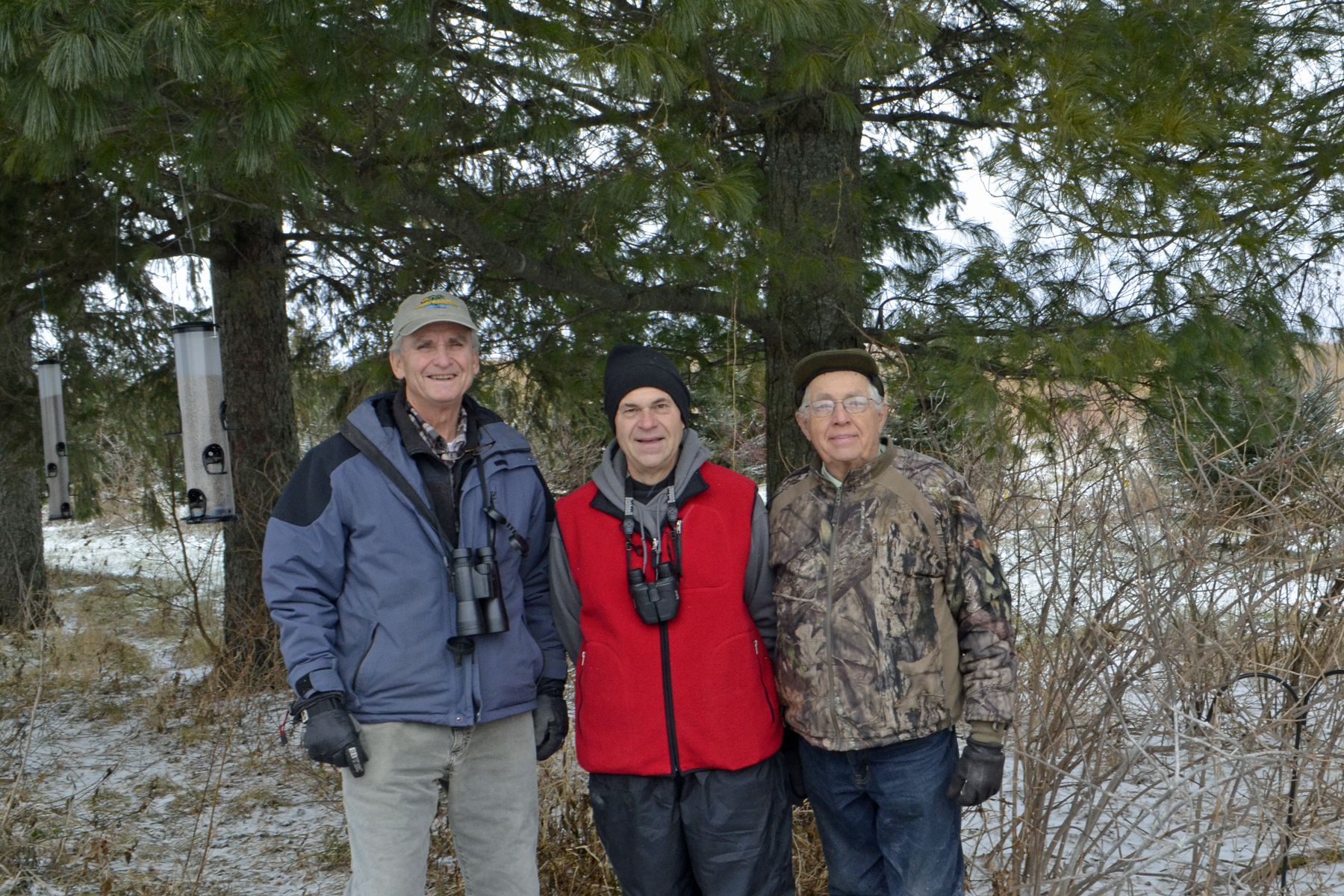On Saturday December, 29 we ended 2018 “The Year of the Bird” by coordinating the 47th Poynette Christmas Bird Count (CBC), with assistance of 26 field counters and 10 households as feeder counters. Fifty-nine species and 10,816 individual birds were documented.
It is very rewarding to spend a day at Goose Pond Sanctuary seeing the winter bird usage as the result of 50 years of land acquisition and habitat restoration. For the 19th year Goose Pond Sanctuary was searched as a unit of the Poynette CBC count with the assistance of Jim Hess, Bill Walters, and JD Arnston.
Jim Hess, Bill Walters, and Mark getting ready to head out. Not pictured: JD Arnston. Photo by Sue Foote-Martin
The count day was slow for many species, however we had a number of firsts and highlights at Goose Pond Sanctuary and the adjacent area. Twenty-seven species, a record high for our count, were found in the Goose Pond area. Black ducks and northern pintails were new to the species list bringing the total species observed to 44. Record high numbers included 1,340 mallards (only found on two other counts with a previous high of 61), 3 American kestrels, and 87 dark-eyed juncos. The second highest number of birds was found – 2,045, thanks to the large number of mallards.
Northern pintail, photo by Monica Hall
Mark, Jim, and Bill spent an enjoyable hour walking the sorghum and sunflower food plot. Ring-necked pheasant tracks were easy to see with the recent half inch of snow. Eight hens and two roosters were flushed and judging from the tracks there might have been 25 birds using the food plot.
The highlight of the food plot walk was the 300 American tree sparrows flitting around. They were not easy to count! At first there were 30 sparrows, then 50, and half-way through the plot we estimated 200 tree sparrows were present. Another 100 were found in the second half of the food plot.
Sorghum in the food plot. Photo by Mark Martin
Chickadees, cardinals, juncos and two cottontails were also found in the food plot, mostly where the spruce trees were adjacent to the food plot. The winter birds fly into the surrounding restored prairie but feed mostly in the food plot on 10 varieties of sorghum. Thanks to the Columbia and Dodge Counties Pheasant Forever chapters for donating sorghum and sunflower seed.
With the abundance of waste corn in the fields and the relatively open winter mallards were still feeding in the Arlington area. The ducks usually visit Goose Pond in mid-morning and on the 29th they found about a tenth of an acre of open water. It was nice to see the black ducks and pintails in the dense flock of mallards roosting on the ice or swimming.
The hawks and great horned owl were present due to the large amount of habitat that resulted in a high number of prey species.
At Christmas time we like to watch Jimmy Steward in It's a Wonderful Life where George Bailey learned how different life would have been in Bedford Falls without him. As we end the 50th year of Goose Pond Sanctuary we wonder how different bird life would have been at Goose Pond Sanctuary without Madison Audubon.
There probably would not be a Poynette CBC and the low number of species would mostly be dominated by rock pigeons, horned larks, and European starlings.
Birds found: Canada goose (6), tundra swan (1), American black duck (3), mallard (1,340), Northern pintail (2), ring-necked pheasant (15), northern harrier (2), Cooper’s hawk (2), red-tailed hawk (1), rough-legged hawk (2), American kestrel (3), rock pigeon (47), mourning dove (68), red-bellied woodpecker (1), downy woodpecker (5), hairy woodpecker (1) feeding on emerald ash borer larva, blue jay (3), American crow (6), horned lark (4), black-capped chickadee (18), European starling (5), American tree sparrow (329), dark-eyed junco (87), northern cardinal (6), house finch (44), American goldfinch (28), and house sparrow (15).
Written by Mark Martin and Susan Foote-Martin, Goose Pond Sanctuary resident co-managers







